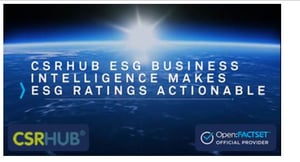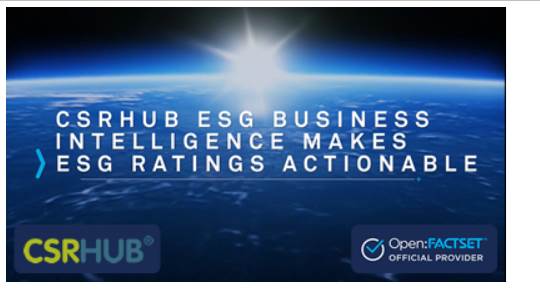This past year of social and environment pressures (Covid-19, racism inequity, climate change, global risks) has created a new wave of demand for ESG data and insight. A growing number of corporates, professional firms and financial asset owners and managers are interested in ESG.
For example, more than 2,800 investors, representing 90% of world financial assets have now committed to the UN Principles for Responsible Investment (UNPRI). In response, companies are clarifying and harmonizing their reporting methodologies. More companies are reporting sustainability information. Around 50,000 entities have shared information about their sustainability performance either directly (about 12,000 have incorporated sustainability data in their public filings) or through participating in sustainability-related organizations or reporting systems.
ESG data providers are participating in this new wave of investor interest by offering:
- Broader coverage of entity types (i.e., public, private, not-for-profit) and coverage of more types of investments (e.g., equities, debt, REITs)
- Comparable, stable scores with enough history that an ESG factor can be used in a quantitative model or automated screening process
- Methods for integrating ESG with other financial and market return data sets
In previous articles we have referred to this new wave as “third-era” investors are driven to integrate ESG data by three themes:
- Marketing. In order to attract and retain assets, investors highlight their ESG methodology and follow it, even if it may result sometimes in underperformance.
- Risk avoidance. Asset managers who prioritize safety and downside reduction may see ESG data as an additional tool for identifying and avoiding risk.
- Materiality. Quantitative analysts have been using “alternative” data sets for years. ESG data may provide a new opportunity for algorithm-driven alpha generation.
ESG data is being integrated into investment processes through direct purchase of individual data sets. They are also being integrated into various types of data curation and distribution systems. ESG data used to be a subcategory of “alternative data.” It has now become its own category and the number of providers and variety of data sets available has grown.
The new wave or “third-era” investment strategies will rely on data sets that have these characteristics:
- Broad, deep coverage. To be useful in an investment process, a data set should cover not only the equities an investor already holds, but also most if not all equities in similar entities. In some industries, there are large privately held competitors. ESG-oriented analysts should like data sets that also cover private companies.
- Streamlined factors, complete coverage of the factors, and a long stable history. Some ESG data sets offer two hundred, one thousand or even several thousand indicators. This amount of detail can overwhelm investors who are relatively new to ESG issues. It is also difficult to fill in all of “slots” in a data set. Many major ESG sources cannot complete 70% or more of their bottom level of indicators. Finally, most financial analysts are used to being able to study market patterns over long time horizons. No ESG data set goes back further than the 1990s—so analysts still cannot see how ESG factors relate to stock performance through a wide range of market conditions. Still, it is helpful if an ESG source has at least ten years of history and if it has made few or no changes to its methodology during this time.
- Works well when combined with other data sets. Many ESG data users purchase more than one type of data. They extract value from combining these data sets to examine different aspects of a company’s sustainability performance. It is important to pick data sets that have enough identifying information (e.g., ticker codes, ISINs, name variations) that they can be combined. It helps too, if it is easy to pull data from a data provider’s site or application programming interface (API).
These investors will demand ESG data sets that give them marketing differentiation, ways to reduce risk, and opportunities to generate alpha. They are likely to use several data sets and combine them in a proprietary way, as they seek to make their understanding of ESG data part of their competitive advantage in the investment marketplace.

For more information on accessing ESG ratings via the CSRHub ESG Business Intelligence data feed, please visit the Open:FactSet Marketplace.
 Bahar Gidwani is CTO and Co-founder of CSRHub. Bahar has built and run large technology-based businesses for many years. Bahar holds a CFA (Chartered Financial Analyst) and was one of the first people to receive the FSA (Fundamentals of Sustainability Accounting) designation from SASB. Bahar worked on Wall Street with Kidder, Peabody, and with McKinsey & Co. He has founded several technology-based companies and is a co-founder of CSRHub, the world’s broadest source of corporate social responsibility information. He has an MBA from Harvard Business School and an undergraduate degree in physics and astronomy. He plays bridge, races sailboats, and is based in New York City.
Bahar Gidwani is CTO and Co-founder of CSRHub. Bahar has built and run large technology-based businesses for many years. Bahar holds a CFA (Chartered Financial Analyst) and was one of the first people to receive the FSA (Fundamentals of Sustainability Accounting) designation from SASB. Bahar worked on Wall Street with Kidder, Peabody, and with McKinsey & Co. He has founded several technology-based companies and is a co-founder of CSRHub, the world’s broadest source of corporate social responsibility information. He has an MBA from Harvard Business School and an undergraduate degree in physics and astronomy. He plays bridge, races sailboats, and is based in New York City.
CSRHub is the largest ESG and sustainability rating and information platform globally. We aggregate 230 million data points from 650+ data sources including leading ESG analyst databases. Our patented algorithm aggregates, normalizes, and weights data to rate 18,000+ companies in 141 countries across 134 industries. We track 97% of world market capitalization. We cover 12 subcategories of ratings and rankings across the categories of environment, employees, community and governance. We show underlying data sources that contribute to each subcategory’s ratings. CSRHub metrics are a consensus view (any 2 sources may have about a 30% correlation so we make sense of the disparate data). We tag companies for their involvement in 17 Special Issues. We provide Macro-enabled Excel dashboard templates, customizable dashboards, and an API. Our big data technology enables 85% full coverage of data across our rated companies and robust analyses. We provide historical ratings back to 2008.


.png)
